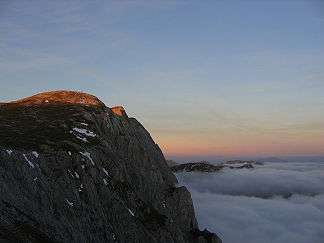Hochschwab
| Hochschwab (mountain) | |
|---|---|
|
The Hochschwab and its south face seen from the Oberen Dullwitz (to the east) | |
| Highest point | |
| Elevation | 2,277 m (AA) (7,470 ft) |
| Prominence | 2,277-1,226 m ↓ Präbichl |
| Isolation | 38.8 km → Hochtor |
| Coordinates | 47°37′05″N 15°08′32″E / 47.61806°N 15.14222°ECoordinates: 47°37′05″N 15°08′32″E / 47.61806°N 15.14222°E |
| Geography | |
| Parent range | Hochschwab Mountains |
| Geology | |
| Age of rock | Anisian - Carnian |
| Mountain type | Wetterstein limestone |
| Climbing | |
| Normal route | via the Aflenzer Staritzen (not difficult) |
 The Hochschwab summit at sunset | |
The Hochschwab in the Upper Styria is a mountain, 2,277 m (AA), and the highest summit in the eponymous mountain range.
Location
The summit of the Hochschwab is a flat, rock and grass-covered dome, that may be reached from the Schiestlhaus (2,153 m (AA)) to the northeast in about half an hour and via the plateau to the west (Biwakschachtel Fleischerhütte[Anm. 1][1][2]) easil climbed can be. The Schiestlhaus may be approached from Seewiesen (974 m (AA)) at the foot of the Steirischer Seeberg via the Seetal valley, the Untere Dullwitz to the Voisthaler Hut, the Obere Dullwitz and the Graf-Meran-Steig, as well as from the north, from Weichselboden in the Salza valley. The showpiece of the Hochschwab is its mighty, south face which has a width of almost two kilometres and rises to a height of up to 300 metres above the Trawies Saddle and the valleys of Trawiestal (to the southwest) and Obere Dullwitz (to the southeast) which meet at that point. There are climbing routes of all grades up the south face.
1988 Hochschwab tragedy
In early November 1988 there was a mountaineering tragedy on the Hochschwab, which triggered the biggest search operation ever undertaken by the Styrian mountain rescue service to that date. A seven-man group was trapped for 2 days and nights in storms and icy temperatures at a height of 2,000 metres above sea level. Following the deployment of 150 Alpine gendarmes and mountain rescue personnel as well as five helicopters, five of the party were already found to be dead and the remaining two survived with serious injuries.[3]
References
- ↑ Touristisches. Die Fleischerhütte auf dem Hochschwab. Badener Zeitung, 31. October 1928, o. 4, right centre
- ↑ Touristik. Die neue Fleischer-Hütte. Badener Zeitung, 1 November 1929, p. 8, below left
- ↑ 7 Alpinisten zwei Tage vermisst
Literature
- Liselotte Buchenauer: Hochschwab, 1960 und mehrere Neuauflagen. ISBN 3-7011-7044-4
- Rudolf Ägyd Lindner: Hochschwab, Weishaupt, 2nd edition, 2002. ISBN 978-3900310264
- Peter Rieder: Alpenvereinsführer Hochschwab. Bergverlag Rudolf Rother, Munich, 1976. ISBN 3-7633-1216-1
Remarks
- ↑ Schutzhaus Fleischerhütte completely razed on 28 May 1928. — See: Allerlei. Brand einer Schutzhütte am Hochschwab. Badener Zeitung, 6 June 1928, p. 5, below left
External links
| Wikimedia Commons has media related to Hochschwab. |
- VR Panoramic photographs of the Hochschwab Mountains
- Hochschwab in: Austria-Forum, the Austrian knowledge network online (local history lexicon)

